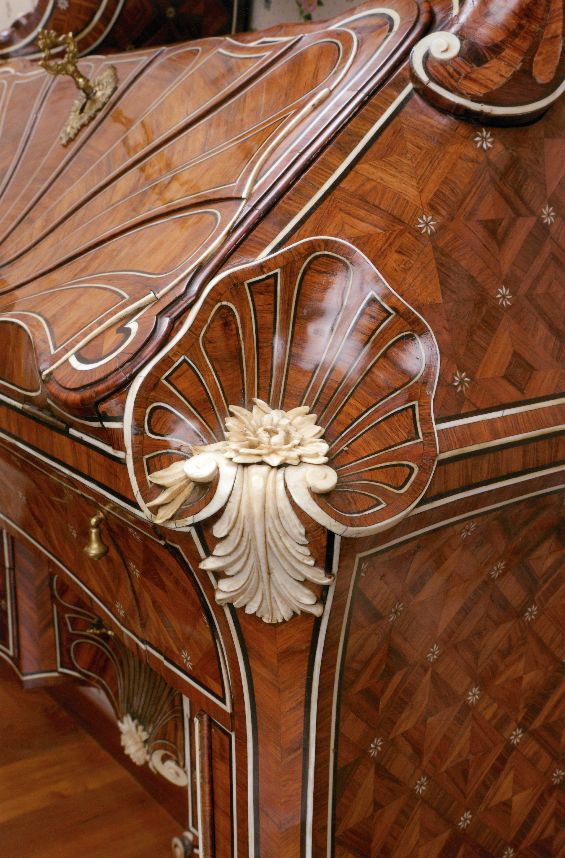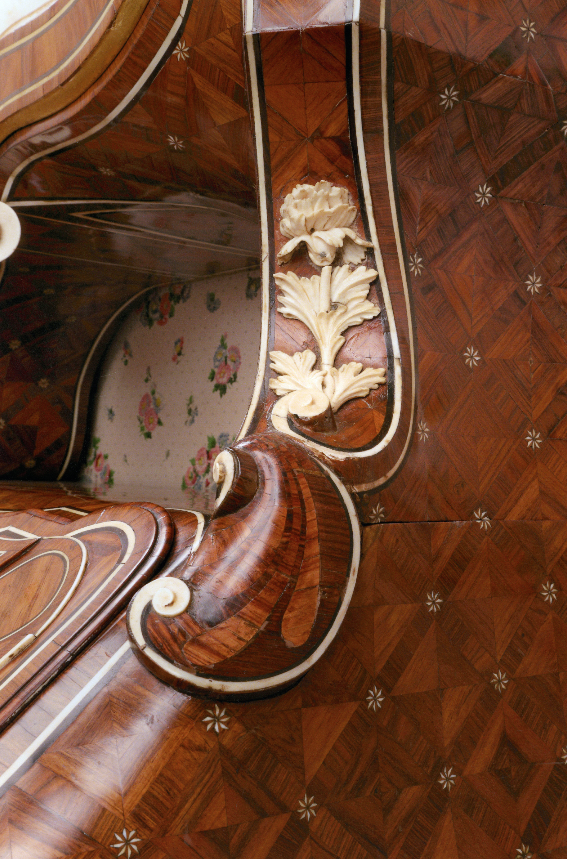Scrivania con scansia, cosiddetta «Ashburton Cabinet» (Secretary Desk, known as the «Ashburton Cabinet»)
Piffetti Pietro
c. 1770
Turin
Fusto in noce e pioppo lastronato in legno rosa a rombi entro griglia di legno
violetto, punteggiata da minuscole girandole a petali bicolori (avorio
e bosso). Applicazioni in avorio intagliato. Specchio allo sportello. Mostrine delle serrature e pomelli in bronzo dorato. Lateralmente
al cassetto maggiore della scrivania (che ha i foderi in ciliegio) sono disposti, a scomparsa, due cassettini a segreto con meccanismo a molla e lamelle di blocco.
Interni: nel corpo inferiore il vano di scrittura è lastronato in radica di noce
e articolato in cinque cassettini in noce d’India, perfettamente levigati e
assemblati senza uso di chiodi. Al centro porta-carte a quattro scompartimenti. L’abattant presenta un rivestimento in tela cerata verde probabilmente originale.
230,5 x 86 x 48,5 cm
Catalogue N. A293
Inv. 0338
Provenance
Exhibitions
Bibliography
web_description
The forms develop in melodious twists and turns, vibrant and restrained at the same time, aware of the past and open to the future.
Body of walnut and poplar veneered with rosewood in a diamond pattern inside a trellis of kingwood dotted with tiny pinwheel motifs with twocoloured petals (ivory and boxwood). Applied elements of carved ivory. Mirror on the door. Gilt-bronze keyplates and knobs. On either side of the main drawer of the desk, lined with cherry wood, is a small secret drawer with a spring and locking mechanism. Interiors. The writing compartment in the lower section is veneered with burr walnut and fitted with five drawers of black walnut, planed perfectly to shape and assembled with no use of nails. Four compartments in the centre for papers. The drop leaf presents a covering of green oilcloth, which is probably original. The interior of the upper section has been altered to insert an incongruous mirror and shelves.
Attributed to Piffetti by Alvar González-Palacios in the catalogue of the Christie’s auction of 1992,1 this desk is by far the most important item of furniture in the Cerruti Collection. It marks a stage in Piffetti’s stylistic evolution and bears exemplary witness to the other side of the great cabinetmaker’s genius. The first, “arch-Baroque” side can be identified in the invention of extravagant shapes and extravagant decoration, and reached its climax in the secretary desks of the Museo Accorsi-Ometto and Palazzo del Quirinale. The second, instead, curbs or even abandons this frenzy of invention and decoration, and appears intent on scaling the most difficult peak of elegance, namely measured restraint. It is as though Piffetti, having demonstrated the wonders of which his art was capable, now wished to make finesse prevail over grandeur, the exquisite over the astonishing. The forms develop in melodious twists and turns, vibrant and restrained at the same time, aware of the past and open to the future.
Suffice it to note the transformation of the connection between the sections. While the idea of the two large volutes, drawn by Piffetti from Juvarra’s design for the bookcases of the royal study,2 is still present, the volutes are now absorbed externally into the continuity of the side and discernible only by a slight depression. The shell, a primary element of the late-Baroque decorative repertoire, is no longer ornamental but structural and stylized rather than naturalistically represented. It appears repeatedly in the secretary desk: tilted back at the top, opened out fanwise on the surface of the drop leaf and expanded to occupy the whole of the drop front (one of Piffetti’s most extraordinary inventions), and in a small format on either side of the same. Narrow ribbons of ivory, standing out still more clearly due to an almost invisible second strip of ebony, run along the edges to emphasise the flowing lines of the desk and end in projecting swirls.
A man of culture and religion, a musician and a painter, he was hailed in the 18th-century literature not as a cabinetmaker but as the cabinetmaker, a creator who drew on the other arts to concentrate them in his own.
The decorative elements of carved ivory in the form of flowery sprigs, rosettes and shells constitute another of the characteristics wholly peculiar to this work. While the two renowned secretary desks by Piffetti mentioned above have suggested the image of fantastic sceptres, this one can be compared to an exquisite musical instrument. Pietro Piffetti created this piece of furniture in more or less the same period as the superb desk with wall-mounted sections for the boudoir of a new apartment of the Duke of Chiablese (1767-68),3 an item of artistic heritage that has recently returned to Italy after decades out of the country. The creative matrix is the same, developed in a princely profusion of coloured ivories and mother of pearl in the Chiablese desk and, instead, with noble restraint in the Ashburton Cabinet. The same leading role in structural and decorative terms is played by the shell motif. The chequered interior facing is the same. The Cerruti desk may be in a lower key as regards magnificence but not expressive intensity.4 Attention should be drawn to a highly similar desk with slightly different measurements (223.5 x 77.5 x 47.5 cm) in the Detroit Institute of Arts, published by Alvar González-Palacios,5 but with an anomaly that casts legitimate doubt on its authenticity. It has been established that the carcass is of mahogany, but this wood was not used structurally in Turin until the 19th century.6
Mention should also be made of the avowed 19th-century copy of the Ashburton Cabinet, produced in England around 1865, auctioned by Christie’s on 26 October 2000 in London (lot 45), measuring 240 x 88 x 48 cm and published in the September-October issue of Christie’s Magazine. The article by Deborah Lambert highlights the phenomenon of copies of famous pieces of furniture produced during the reign of Napoleon III to meet the demands of an increasingly wealthy middle class eager to show off its riches and lacking in rigorous culture. As she writes, there was no disdain for copies as long as they were of important models and finely crafted. Cabinets, in particular, underwent a sort of revival and Lord Ashburton himself was indeed a customer of François Linke, one of the major copyists of luxury items.7 Piffetti’s desk appears to be the only piece of Italian furniture to enjoy the honour of being copied.
Pietro Piffetti (1701-77) was born in Turin in 1701. The first thirty years in the life of one of the greatest cabinetmakers of the century are still shrouded in mystery. It is known that he was the son of an innkeeper, that he served his apprenticeship in Turin (probably in the workshop of the Venetian master Ludovico Derossi), that he married there in 1722, and that he qualified as a mastro approvato in 1723. While this volume was already in an advanced stage of preparation, in December 2020 a new study added elements to the reconstruction of Piffetti’s early activity: C. Cagliero, La formazione giovanile di Pietro Piffetti, Regio Ebanista alla corte dei Savoia, Ivrea. It is not until 1730 that we find any documentation on Piffetti, namely a series of records in the Turin State Archives. These tell us that he was living and working as a cabinetmaker in Rome, where he had joined a brother in the same profession. Some light has been shed on his activities in Rome by the discovery of two console tables whose tops, richly inlaid with floral decoration, are very similar to those of a series of Piffetti wall tables (three in Turin and one in London). The tables are the work of Pierre Daneau, a French cabinetmaker active in Rome, which makes it possible to deduce that Piffetti spent some time in his workshop. Piffetti’s triumphant return to Piedmont came in 1731, when he was summoned by the king of Savoy and appointed to the post of royal cabinetmaker, specially created just for him, thus outstripping all of the local craftsmen. He made his debut at the royal court in Turin with spectacular decorations for the chamber of affairs of state, later the Queen’s dressing chamber, drawing inspiration from a design by the court architect Filippo Juvarra. These were followed over a period of more than forty-five years by 222 works documented for the House of Savoy as well as an unknown number for private clients, in which he displayed scintillating genius for innovations as regards forms and ornamentation, as well as dazzling technique.
A man of culture and religion, a musician and a painter (as attested by two recently discovered engravings), he was hailed in the 18th-century literature not as a cabinetmaker but as the cabinetmaker, a creator who drew on the other arts to concentrate them in his own. He died in 1777 and was buried in the cathedral of Turin. His tombstone has disappeared.
Roberto Antonetto
1 González-Palacios 1992 (pp. 190-198, lot 166). It was knocked down for £770,000, one of the highest prices of a lean year according to the article by Geraldine Norman in the Independent (2 August).
2 The drawing (Biella, Fondazione Sella, F. Maggia archive, no. 548) is published by Giuseppe Dardanello. See Dardanello 2001, pls. 72 and 73; Dardanello 2007, pl. 55.
3 Antonetto 2010, vol. I, pp. 258-263.
4 The same spirit (and indeed the same marquetry) are found in a contemporary table that recently resurfaced in the exhibition Genio e Maestria over half a century after the Mostra del Barocco Piemontese of 1963 (R. Antonetto, in Venaria Reale 2018, p. 240).
5 González-Palacios 1973, p. 67; Id. 1984, vol. II, p. 384, figs. 849, 851 and pls. LX82-385 and LX.
6 The materials were indicated as “Mahogany, oak, walnut, veneered with kingwood, ivory, and ebony stringing, etc.” by the museum in 2000 and as “Kingwood, ivory, and ebony on wood carcass, mirrors etc.” in 2008.
7 For the fortunes of Linke and contemporary makers of luxury furniture such as Henry Dasson, the Beurdeleys and the Sormanis, see Payne 2003; Sotheby’s, New York, A Private Collection. Important French Furniture and Decorations, including Signed Furniture and Items from Linke Family Private Collection, 26 October 2006.


